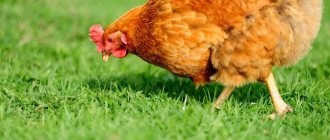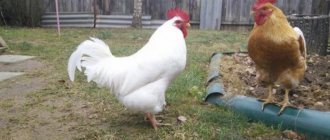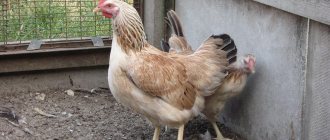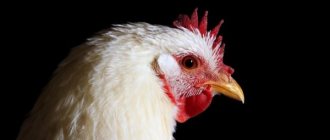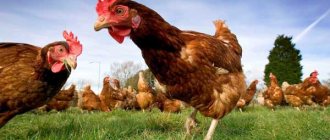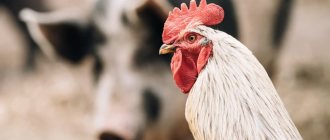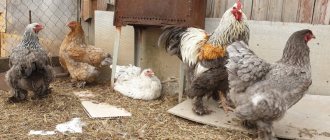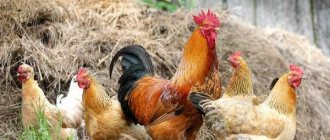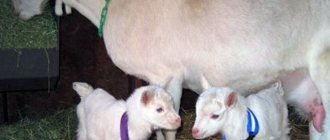The Poltava clay breed of chickens, bred in Ukraine, has a meat and egg production orientation. Therefore, it is considered beneficial for keeping on small farms and large farms. The peculiarity of Poltava clay chickens is their resistance to the external environment and immunity to harsh climates. In addition, they do not require complex care and easily tolerate errors in maintenance. However, certain requirements must still be met.
Where did the breed come from?
The Poltava breed of chickens was bred in the region of the same name in Ukraine in the 19th century. The Wyandotte, New Hampshire and Orpington breeds were used for crossing.
The goal was to breed universal birds that would produce a lot of eggs, provide dietary meat, and be frost-resistant.
Selection work went on for two centuries, but was suspended with the collapse of the USSR. Part of the breeding stock of Poltava chickens was reduced, and work to improve the breed was postponed.
Due to negative changes, the breed has lost some valuable qualities. But today work continues to improve the characteristics - breeders are trying to achieve the same results.
Officially, Poltava chickens received recognition only in 2007.
A description of the Poltava clayey rock will allow you to get an idea of its main characteristics.
Breeders reviews
Many owners give positive characteristics to this breed:
- Poltava chickens quickly begin to lay eggs, gain weight well and are not demanding in feed, which makes it possible to significantly save on their maintenance;
- some choose this breed because of its tasty and juicy meat, which, with a balanced diet, contains virtually no fat;
- many are attracted by the calm and peaceful nature of birds, which allows them to be kept with others;
- Many farmers are engaged in natural breeding of livestock, and the result is quite successful - a hen can breed 2-3 offspring per season.
Varieties
There are three lines of Poltava rock: clayey, black, zozulyasty.
The black subspecies is mainly bred in Poltava. There are only a few dozen representatives of this breed line, but breeders do not lose hope of increasing their number.
Zozulyasty Poltava chickens are also called cuckoo chickens. Chickens have beautiful plumage: a wide stripe of light color alternates with dark. They are lightweight. The species is on the verge of extinction.
Clay Poltava chickens are the main representatives of the breed; there is a large population. This species is common in Russia and the CIS countries.
Next, the characteristics of the clayey variety of rock are discussed in detail.
History of the origin of the breed line
The breed owes its origin to several foreign and domestic laying hens; New Hampshire, Orpington, Wyandotte and local chickens took part in the selection. The first positive results were presented in the middle of the 19th century, but improvements are still being made.
The public became familiar with Poltava laying hens in 1895 at an exhibition of farm animals. It was then that experts paid attention to it, after which work was carried out to improve egg production, thanks to which two more varieties of the breed appeared. In total the line includes three types:
- Clay is the most common individual.
- Black - is on the same level as described above, but has a black feather color.
- Zozulistaya (Poltava calico) is a rare form that is found exclusively in private collections and has a cuckoo coloration.
A characteristic difference between all types is the color and level of performance.
Peculiarities
Build and color
On the small head of clay Poltava chickens there is a pink comb. Its common form is in the form of a rose; leaf-shaped is less common. The eyes are yellow-red, the earlobes and earrings are red, covered with small white dots. The small beak is yellow. The face has pink or red bristles.
The birds have a short and strong neck, a rounded chest, and a wide and long back. The wings fit tightly to the body. An obtuse angle is formed between the body and tail. The legs are yellow with slightly protruding shins, widely spaced and not covered with feathers.
Chickens of the Poltava clay breed have brown plumage: from light to dark shades. The tip of the pen is painted black.
You can distinguish a cockerel from a hen by several characteristic features:
- long and light neck;
- black tail feathers with green tips;
- along a more developed torso;
- body weight (more than that of females by 1 kg);
- large comb with 5 teeth.
Bird character
The Poltava clay hen is distinguished by its developed maternal instinct. She diligently sits on the clutch and then takes care of raising chickens. Not aggressive towards other animals and birds.
Chickens are friendly towards people. They allow them to clean the house and withstand any manipulation. Roosters are characterized by smooth and decisive movements. The birds do not fight among themselves; they are loyal to representatives of other breeds.
Meat characteristics
Poltava clay hens weigh 2.5 kg, roosters weigh a little more - 3.5 kg. After processing the carcass, about 1.3 - 1.8 kg of live meat is obtained. Bones do not take up more than 11% of the weight.
The carcass of Poltava clay chickens is famous for the presence of a fatty layer - when cooked, it releases juice, making the pieces juicy and tender. Despite this, fillet is low in calories and can be consumed by people on diets.
Chicken feathers and down are valuable materials. The Poltava breed is distinguished by good plumage; up to 100 g of material can be collected from each bird. It is used to stuff pillows and blankets.
Egg production
Poltava clay chickens are in demand due to their early ripening.
The hen lays her first eggs at 20 weeks. In a year it turns out to be 200, in rare cases - 300 pieces.
The eggs are large, weight - 55 g. The shell is brown - a consequence of the work of the golden color gene. Thick and strong, contains a lot of calcium. Eggs have a predominant protein content, which makes them valuable for athletes building muscle mass.
Poltava chicken eggs have a high fertility rate of 83%. The survival rate of offspring is 100%.
The maximum peak of egg production is from 7 months to 1.5 years. They do not lay eggs during the molting period. By the fifth year of a bird’s life, it is reduced to 60% and it is unprofitable to keep laying hens any longer. Therefore, the livestock requires updating.
Reproduction
To successfully replenish the population, Poltava clay breed can be bred at home. The optimal ratio in the herd is 8 hens to 1 rooster.
The birds are distinguished by excellent maternal instinct and diligently sit on the masonry. It is necessary to check the nests regularly, as there is a risk of eggs brooding, causing them to deteriorate.
One hen hatches up to 15 eggs. The female is fed well and ensured that she drinks on time. You should not let her leave the nest for more than 15-20 minutes a day.
Chicks of the clayey Poltava breed hatch in 21 days. It is better to start breeding in April and end in the fall, since in the warm season there is an abundance of succulent food.
The weight of the chicken is on average 40 g, the color of the down is light brown. With proper nutrition, the chick reaches a weight of 250 g in the fourth week.
Maternal instinct
Mother can be taken as an example to her relatives, because by nature she has excellent maternal qualities. Thanks to the developed brooding instinct, you can breed chicks without an incubator. For the birth of small, vocal chicks, the mother needs 21-22 days. Experienced poultry farmers recommend planting the hen in April-May. One mother is able to give her warmth to 14-15 testicles at a time.
Helpful advice:
- It is important to ensure that the mother sitting on the eggs always eats on time, especially at the beginning of the process. Hunger and thirst are the only motive that can make her give up her eggs and go in search of food.
Basics of proper feeding
Children's menu
For the first 3 days, the chicks are given only a mash of steamed millet, cottage cheese, and boiled eggs. The mixture promotes digestion and provides energy. Then crushed corn, cooked vegetables and green onions are added to the mash.
The ingredients are added one at a time and the chicks' reaction is monitored. The calorie content of chicks' food should be 20% higher than that of adult Poltava clay chickens. After 2 weeks of life, the chickens are added to the mash with feed. Its share of the total volume does not exceed 10%.
Examples of diet for adult birds
Poltava clay chickens are fed a grain-based diet. Corn is preferred, but other types are acceptable. The diet should contain at least 20% protein.
Seasonal fruits and root vegetables are provided in small quantities. Greens must be added. There is always a drinking bowl with clean water in the poultry house. Mineral supplements are added to compensate for the lack of calcium: shell rock, limestone.
Winter diet
In winter, Poltava clay chickens are fed twice a day, at the same time. This way the birds get used to the routine, which increases productivity.
Grass meal or dry nettle is added to the feed to compensate for the lack of vitamins. The portions are increasing a little. The birds are given vegetables: beets, Jerusalem artichokes, carrots. The fruits are crushed or hung in a string bag in the poultry house.
Poltava clay chickens should not be overfed with vegetables - this causes diarrhea.
Summer diet
In the summer, chickens are fed once a day and allowed to go for a walk, where they will get their own food. The basis of the diet is grains, hay flour, fiber, protein and vitamins. The portion should be smaller than the winter portion.
You can find ready-made chicken feed on sale. When using them, you don't need to add anything else. Water demand increases by 30%.
Laying hens are fed moderately - excess nutrients lead to decreased productivity. If the bird has gained excess weight, fiber is added to it. If you are underweight, increase concentrated feed. Be sure to control the amount of protein in the diet, since the quality of the eggs depends on it.
When there is a lack of calcium, chickens peck at the shells. Therefore, they should have chalk or shell rock freely available.
Overweight
Chickens of the Poltava clay breed have a tendency to become overweight. Obesity occurs due to improper feeding with large amounts of high-calorie substances. A sedentary lifestyle and lack of exercise also negatively affects weight.
Obese birds do not lay eggs well, live short lives, and their meat significantly loses its taste. In chickens, the maternal instinct is disrupted.
In the case of cage keeping, it is necessary to add fine stones to the birds’ diet. They will stimulate digestion.
Poltava clay chickens pros and cons
Advantages and disadvantages of the breed in comparison with other breeds.
The main advantages of Poltava clay chickens include:
- sufficiently high meat and dairy productivity;
- precocity of young animals;
- good weight gain;
- females have good maternal instinct;
- high resistance to cold;
- good taste of eggs and meat.
This breed also has some disadvantages:
- individuals are quite voracious and can eat without stopping. As a result, the birds become fat, which negatively affects egg production;
- resistance to some diseases is below average;
- With age, the egg production of laying hens decreases sharply.
But this breed has few disadvantages, and its advantages are undeniable.
Correct content
Outdoor life
Chickens of the Poltava breed are frost-resistant and hardy. Adaptive abilities allow you to adapt to any conditions: short daylight hours, inclement weather.
In the poultry house, the temperature does not drop below 5 degrees and does not exceed 27 degrees. It is advisable to keep Poltava chickens in open-air cages, but floor-based ones are allowed. A bedding of sawdust, peat or straw is placed on the floor.
It is changed once a week. When wet, the likelihood of developing diseases of the respiratory system increases, mold and mildew appear. If it is too dry, mites will appear.
Be sure to make a container with dry sand and ash - the chickens clean their feathers in it.
Drinkers and feeders are placed in a bright place; it is advisable that they have a special mesh on them that will allow the chicken to stick only its head through.
Cellular content
Cages allow you to place a large number of clay Poltava chickens in a small area.
There should be plastic or metal trays under the cages to collect droppings. They are washed every day.
The cages are disinfected once every two weeks. Otherwise, the spread of parasites and diseases may begin.
Heating
In regions with a temperate climate, additional heating of the poultry house is not required. But there should be no cracks, cracks or drafts in it. In this case, even in winter a comfortable temperature will be maintained.
In the northern latitudes, the poultry house for Poltava clay chickens is carefully covered with insulation - all the cracks are sealed with it. The walls and roof must be double - polystyrene foam or mineral wool is placed in the cavity. Do the same with the floor.
If necessary, use electric heaters.
Walk
Walking allows you to reduce feed costs. Exercise is an excellent prevention of obesity and stimulates digestion. Chickens look for pebbles and bugs, providing themselves with everything they need.
The appearance of babies
Small chicks hatch, golden or light brown - in clay ones. Black chicks hatch like this. Zosular cubs have a grayish color. The offspring are quite strong and hardy if you create optimal conditions for them.
Chicken diet
In the first week, the cubs should be fed the traditional food for this period - mashed boiled eggs mixed with semolina or fine corn grits. When 3 days have passed, you can add greens.
Experienced farmers recommend adding yogurt or other fermented milk products to children. Already ten-day-old babies can add ground shells for full development.
Common diseases
Chickens of the Poltava clay breed are distinguished by good health. They can be infected with parasites - helminths or ticks. The main symptoms are lack of appetite, weight loss, loose droppings, and lethargy. Treatment and further actions are determined by the veterinarian.
Prevention - timely treatment of the poultry house and cleaning of the litter.
The most dangerous disease is chicken coccidiosis, which occurs mainly in chickens. It destroys the intestines and reduces immunity. Symptoms: blue skin color of the chicken, liquid feces, weight loss, lethargy.
Young Poltava clay chickens must be vaccinated, otherwise many diseases are fatal.

